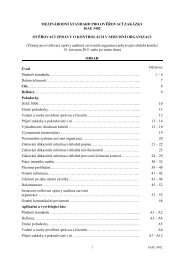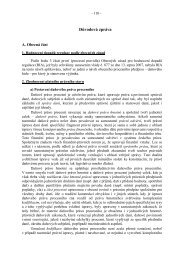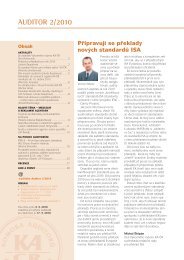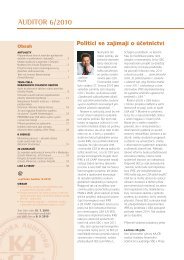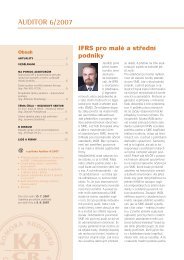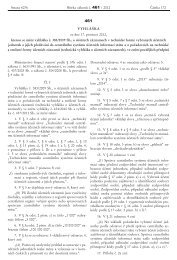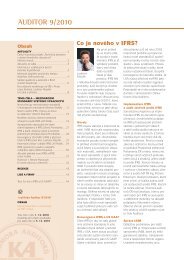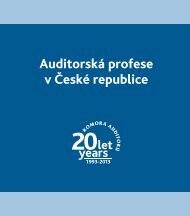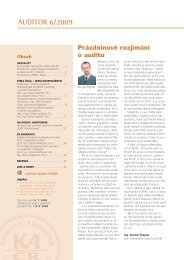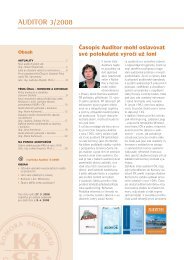Guide to Using International Standards on Auditing in - IFAC
Guide to Using International Standards on Auditing in - IFAC
Guide to Using International Standards on Auditing in - IFAC
You also want an ePaper? Increase the reach of your titles
YUMPU automatically turns print PDFs into web optimized ePapers that Google loves.
119<br />
<str<strong>on</strong>g>Guide</str<strong>on</strong>g> <str<strong>on</strong>g>to</str<strong>on</strong>g> <str<strong>on</strong>g>Us<strong>in</strong>g</str<strong>on</strong>g> <str<strong>on</strong>g>Internati<strong>on</strong>al</str<strong>on</strong>g> <str<strong>on</strong>g>Standards</str<strong>on</strong>g> <strong>on</strong> <strong>Audit<strong>in</strong>g</strong> <strong>in</strong> the Audits of Small- and Medium-Sized Entities Volume 1—Core C<strong>on</strong>cepts<br />
Perform<strong>in</strong>g Substantive Procedures at an Interim Date<br />
When substantive procedures are performed at an <strong>in</strong>terim date, the audi<str<strong>on</strong>g>to</str<strong>on</strong>g>r should perform further<br />
substantive procedures, or substantive procedures comb<strong>in</strong>ed with tests of c<strong>on</strong>trols, <str<strong>on</strong>g>to</str<strong>on</strong>g> cover the rema<strong>in</strong><strong>in</strong>g<br />
period. This provides a reas<strong>on</strong>able basis for extend<strong>in</strong>g the audit c<strong>on</strong>clusi<strong>on</strong>s from the <strong>in</strong>terim date <str<strong>on</strong>g>to</str<strong>on</strong>g> the<br />
period end, and reduces the risk that misstatements exist<strong>in</strong>g at the period end are not detected. However, if<br />
substantive procedures al<strong>on</strong>e would not be sufficient, tests of the relevant c<strong>on</strong>trols should also be performed.<br />
Procedures <str<strong>on</strong>g>to</str<strong>on</strong>g> Address the Period between the Interim Date and Period End<br />
When procedures are performed at an <strong>in</strong>terim date:<br />
• Compare <strong>in</strong>formati<strong>on</strong> at the period end with comparable <strong>in</strong>formati<strong>on</strong> at the <strong>in</strong>terim date;<br />
• Identify amounts that appear unusual. These amounts should be <strong>in</strong>vestigated by perform<strong>in</strong>g further<br />
substantive analytical procedures or tests of details for the <strong>in</strong>terven<strong>in</strong>g period;<br />
• When substantive analytical procedures are planned, c<strong>on</strong>sider whether the period-end balances of<br />
the particular classes of transacti<strong>on</strong>s or account balances are reas<strong>on</strong>ably predictable with respect <str<strong>on</strong>g>to</str<strong>on</strong>g><br />
amount, relative significance, and compositi<strong>on</strong>; and<br />
• C<strong>on</strong>sider the entity’s procedures for analyz<strong>in</strong>g and adjust<strong>in</strong>g the classes of transacti<strong>on</strong>s or account<br />
balances at <strong>in</strong>terim dates, and for establish<strong>in</strong>g proper account<strong>in</strong>g cu<str<strong>on</strong>g>to</str<strong>on</strong>g>ffs.<br />
The substantive procedures related <str<strong>on</strong>g>to</str<strong>on</strong>g> the rema<strong>in</strong><strong>in</strong>g period depend <strong>on</strong> whether the audi<str<strong>on</strong>g>to</str<strong>on</strong>g>r has performed<br />
tests of c<strong>on</strong>trols.<br />
Use of Substantive Procedures Performed <strong>in</strong> Prior Periods<br />
The use of audit evidence obta<strong>in</strong>ed from substantive procedures performed <strong>in</strong> prior periods may be useful<br />
<strong>in</strong> audit plann<strong>in</strong>g, but (unless there is <strong>on</strong>go<strong>in</strong>g relevance <str<strong>on</strong>g>to</str<strong>on</strong>g> the current year such as the cost price of n<strong>on</strong>current<br />
assets or details of c<strong>on</strong>tracts) it usually provides little or no audit evidence for the current period.<br />
10.3 External C<strong>on</strong>firmati<strong>on</strong>s<br />
Paragraph #<br />
ISA Objective(s)<br />
505.5 The objective of the audi<str<strong>on</strong>g>to</str<strong>on</strong>g>r, when us<strong>in</strong>g external c<strong>on</strong>firmati<strong>on</strong> procedures, is <str<strong>on</strong>g>to</str<strong>on</strong>g> design and<br />
perform such procedures <str<strong>on</strong>g>to</str<strong>on</strong>g> obta<strong>in</strong> relevant and reliable audit evidence.<br />
Paragraph #<br />
Relevant Extracts from ISAs<br />
505.7 When us<strong>in</strong>g external c<strong>on</strong>firmati<strong>on</strong> procedures, the audi<str<strong>on</strong>g>to</str<strong>on</strong>g>r shall ma<strong>in</strong>ta<strong>in</strong> c<strong>on</strong>trol over external<br />
c<strong>on</strong>firmati<strong>on</strong> requests, <strong>in</strong>clud<strong>in</strong>g:<br />
(a) Determ<strong>in</strong><strong>in</strong>g the <strong>in</strong>formati<strong>on</strong> <str<strong>on</strong>g>to</str<strong>on</strong>g> be c<strong>on</strong>firmed or requested; (Ref: Para. A1)<br />
(b) Select<strong>in</strong>g the appropriate c<strong>on</strong>firm<strong>in</strong>g party; (Ref: Para. A2)<br />
(c) Design<strong>in</strong>g the c<strong>on</strong>firmati<strong>on</strong> requests, <strong>in</strong>clud<strong>in</strong>g determ<strong>in</strong><strong>in</strong>g that requests are properly<br />
addressed and c<strong>on</strong>ta<strong>in</strong> return <strong>in</strong>formati<strong>on</strong> for resp<strong>on</strong>ses <str<strong>on</strong>g>to</str<strong>on</strong>g> be sent directly <str<strong>on</strong>g>to</str<strong>on</strong>g> the audi<str<strong>on</strong>g>to</str<strong>on</strong>g>r;<br />
and (Ref: Para. A3-A6)<br />
(d) Send<strong>in</strong>g the requests, <strong>in</strong>clud<strong>in</strong>g follow-up requests when applicable, <str<strong>on</strong>g>to</str<strong>on</strong>g> the c<strong>on</strong>firm<strong>in</strong>g<br />
party. (Ref: Para. A7)




